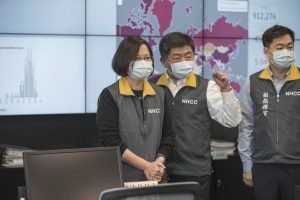The whole world is fighting against the coronavirus pandemic. Facing a new virus, infectious disease experts as well as government officials gear up to implement measures to control and mitigate its damage. Several Asian governments have been touted for their relatively successful control of the first wave of the epidemic: Singapore, South Korea, and Hong Kong. What’s left out in the discussion is what a small Pacific Ocean island the size of Maryland has achieved in fighting COVID-19. The reason? The island of Formosa, or Taiwan, is not a member of the WHO. No explicit data from Taiwan has been shown in the WHO daily briefings.
Hit hard by the 2003 SARS epidemic that claimed 73 Taiwanese lives and affected another 346, Taiwan undertook serious preparations for a future epidemic. Thus the country became hypervigilant once the first case of mysterious pneumonia was reported in Wuhan, China. On January 20, Taiwan established a Central Epidemic Command Center (CECC) composed of medical and public health experts and spearheaded by Vice President Dr. Chen Chien-jen, himself a well respected epidemiologist, and led by Dr. Shi-Chung Chen. Surveillance, contact tracing, and isolation/quarantine were implemented straight away. Taiwan has managed to maintain a low case count through vigorous public health measures. There has not been any shut down of theaters, department stores, and, most importantly, schools although large gatherings are discouraged.
Taiwan saw a surge of cases March, mostly among students or expatriates returning from Europe and North America. While it put additional strain on the system, a strict quarantine was executed. Today a total of 80,000 people are under isolation and monitored with daily temperature and symptom checks, which are tracked by phone. Should the GPS data from a quarantined person’s phone indicate movement outside of a certain range, a follow-up phone call will be placed to confirm the person’s location.
Taiwan started COVID-19 RT-PCR tests in January. At the beginning tests were applied to people returning from the epidemic area or symptomatic patients with relevant travel history. When there was a surge of case numbers in neighboring Asian countries, health authorities did a retrospective screening of patients reported as having a severe flu. This identified the first case without any travel history (it turned out that the patient was a cab driver who had given a ride to a passenger from Zhejiang, China, another epidemic region). The CECC swiftly adjusted its criteria for surveillance and testing based on the development of the epidemic. Most recently, any patients who report a loss of the sense of smell or taste are mandated to be tested.
There are 373 cases as of April 6. In contrasts to previous reports from China, the patient demographic in Taiwan is much younger (with a median age of 32) with more female than male patients (57 to 43 percent). Of note, only 49 percent of patients presented with fever while 37 percent had rhinorrhea (commonly referred to as a runny nose). Only 7 percent of patients presented with full-blown pneumonia.
In addition to requiring physical distancing of more than 1 meter in public, as of April 1, face masks are mandatory when taking public transportation. As early as January, Taiwan’s government ramped up the production of face masks and other personal protective equipment (PPE) as well as critical medical supplies. Sophisticated plans have been mapped out to triage patients to better utilize negative pressure rooms in preparation for any surge of community acquired patients.
We are cautiously optimistic, with sporadic community acquired cases without travel or contact history.
Fighting the coronavirus is an all-hands-on-deck effort; CECC leads the effort with very effective coordination between government agencies. A “epidemic fighting fleet” has been assembled by the Department of Transportation to pick up passengers returning from epidemic areas to facilitate contact tracing. Apps were developed to streamline face mask buying. The virus might mutate fast, but our trans-agency effort also responds swiftly.
In addition to strict public health measures, we also strive to develop point of care diagnostics and antibody assays, hoping to advance the science as well as better identify patients. The thriving biomed industry in Taiwan is taking part in the development of therapeutics and vaccines; Silmitasertib (CX-4945) is one promising candidate being investigated right now.
Taiwan is not only a beacon of democracy, but also living proof that control of an emerging virus can be achieved through science, technology, and democratic governance. No draconian autocratic measures are required.
Christine Chiou is a pediatrician specializing in infectious diseases working at the National Institutes of Health in the United States. She trained and practiced in Taiwan and participated in Taiwan’s efforts to fight the SARS epidemic in 2003. The views expressed in this article are hers alone.
































